 Click to see the QSL!
Click to see the QSL!| Video sequence | Size | Length (secs) |
Download Time (mins) |
Source |
| The 1996 DXpedition to Sable Island (CY0) | Based on 28.8kb/s V.34 modem | |||
| 1620k | 30 secs | 7m56s | VE9AA | |
| 1608k | 25 secs | 7m52s | VE9AA | |
![]() Mike, CY0AA, calling CQ as heard by Geoff, GJ4ICD, as heard
in Jersey (July 1st 1996) tnx: GJ4ICD
Mike, CY0AA, calling CQ as heard by Geoff, GJ4ICD, as heard
in Jersey (July 1st 1996) tnx: GJ4ICD
![]() Mike, CY0AA, on weak
SSB as heard by Geoff, GJ4ICD, as heard in Jersey (July 1st 1996). tnx:
GJ4ICD
Mike, CY0AA, on weak
SSB as heard by Geoff, GJ4ICD, as heard in Jersey (July 1st 1996). tnx:
GJ4ICD
![]() CY0AA's QSO with GJ4ICD, as heard on Sable (July 1st 1996) tnx VE9AA (I particularly like the "I love it, I love it, thank you
Lord!" remark in a CW QSO!, G3WOS)
CY0AA's QSO with GJ4ICD, as heard on Sable (July 1st 1996) tnx VE9AA (I particularly like the "I love it, I love it, thank you
Lord!" remark in a CW QSO!, G3WOS)
![]() The very first
European QSO, EH1YV, as heard on Sable (June 20th 1996 @ 22:14) tnx VE9AA
The very first
European QSO, EH1YV, as heard on Sable (June 20th 1996 @ 22:14) tnx VE9AA
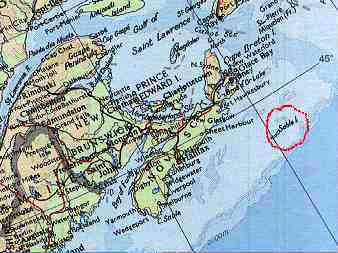 Sable Island, just off the coast of Nova
Scotia.
Sable Island, just off the coast of Nova
Scotia.
Sable Island is but a sliver of a sand bar, located roughly 130 miles ESE of Halifax, Nova Scotia. It is about 25 miles long and one mile wide at its widest point. The dunes and the island's tips are constantly changing shape, in fact actually moving the island 25 or so miles in the last few hundred years. The long sandbars that extend outwards into the Atlantic make landing by boat very dangerous, giving rise to literally hundreds of shipwrecks over the centuries. Hence its nickname: "The Graveyard of the Atlantic".
It has historically been very difficult to gain permission to operate from Sable because of the stringent rules, regulations and policies governing the island. I suppose that is part of its allure. There are only three full-time residents: an officer in charge (Gerry Forbes), a weather station technician and a handyman. The weather station worker and the handyman switch off to the mainland for various length shifts anywhere from one to six months.
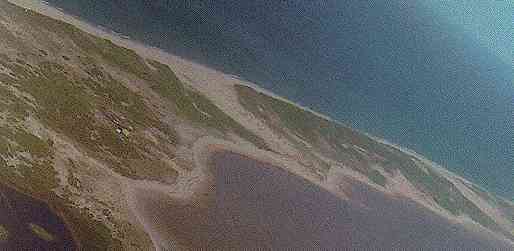 Aerial view of Sable, east of main station
Aerial view of Sable, east of main station
The expedition all started in early 1995, when Bob, VE1YX mentioned to me that Ken, WA8JOC was looking for a Canadian operator (a prerequisite for a CY0 licence), preferably a VHFer. Bingo! I was on the phone right away to Ken, who I knew of already because he had sent me my A22MN and 9L1US cards for Dave Heil. I had some experience with pileups operating from many IOTAs around the Maritimes and from many years of contesting from semi-rare New Brunswick.
Little did we know that the cost of expedition, and the work involved, would be far more than we had ever imagined. Licences, landing permission and getting a place to stay on Sable would not be easy. Also, chartering several planes and enlisting the help of the Canadian Coast Guard would prove to be a task in itself. We decided on June '96, partly because of my desire to work Europe on six metres but also to fit in with W9OEH/WA8JOC's vacation schedules. Luckily for us, two plane charters and the yearly Coast Guard ship's schedules closely fit our own. I was very hopeful.
The team was originally to include two more Canadian operators: Jerry, VE3XPM (VE1DE), a friend and fellow IOTA DXpeditioner and Doug, VE1PZ, another friend and a keen fellow six metre DXer. Unfortunately, after reviewing the high costs of doing the expedition it soon became apparent that adding just two more ops would double the cost of the operation. The team then forged consisted of Ken WA8JOC, Wayne W9OEH (now K8LEE once again) and Mike VE9AA (ex-VE1MQ).
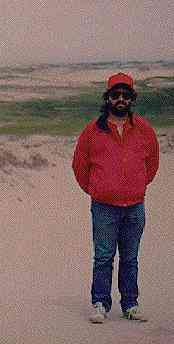 VE9AA
on "Bald Dune".
VE9AA
on "Bald Dune".
Because of the high costs, and a commitment I had made to the six metre world, I would arrive first and set up shop, concentrating on ironing out bugs and informing the other two ops of any forgotten gear, etc. (I told them to bring more bread, milk, and potatoes...) but hopefully make many CYØ QSOs to Europe in the historically FB transatlantic window (June 18-24th).
Through the help of Gerry Forbes we were able to establish the centre of our operations near the weather station inside the main "compound" on the island . This was not without some consequence but this area was one of the few places we were allowed to operate from or that had 110vac readily available. Generator switch-overs, telephone RFI, TV-RFI and RX-data RFI were some things we had to work around at various times through our stay. Also, we were somewhat limited as to where we could set up our antennas, run our feed lines etc.- so we couldn't install the Beverage RX antenna for 160 metres, nor the really big six metre beam. Three antennas and an IC-706 sponsored by Oklahoma Comm Center would make up my arsenal of six metre gear. I also had 350W+ and a 17b2 for two metres, just in case the MUF rose above 50MHz towards Europe. EME skeds were made at the last minute, and a few qsos on tropo were made as well.
I kept secret the fact that my SB200 (with six metre mod) and a GaAsFET were going along too, so as not to get the expectations of the six metre crowd up too high. Looking back, with the terrible conditions, it's a good thing that I was loaded for bear on Six, as many Q's were made on scatter, or meteor assisted, or just plain "in-the-noise". Without a good rig and antenna, 500W, and an RX preamp, many QSOs wouldn't have been in the CYØAA six metre log (sure glad I took the stuff!). Early on the second day I actually put a few Qs in the six metre log just with the Ringo, originally intended just to be used on 50.101 while were sleeping or eating and as a beacon antenna after we left Sable. Due to complications that I can't go into, permission was retracted for a permanent 50MHz beacon on Sable I. After getting fully set up on the second day, with dipoles, slopers beams, amps etc. I was really looking forward to those pileups, but they were not to be. I worked 4500 QSOs (mostly HF) the first few days , and was becoming pretty disheartened with Six as there were very few openings, although I was able to manage many scatter contacts into W1/2/3... Even openings Stateside were few and far between except just one day when I think I worked every W4 in Florida... All in all I had seven days with little or no six metre propagation. Unheard of!
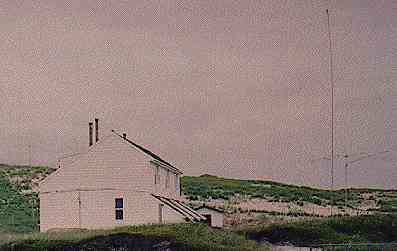 The
Shack, "Triplex House".
The
Shack, "Triplex House".
The original plan was to operate on 50.164 or 50.101, but I had so much trouble generating ANY interest at all, I was forced to be on 50.125 or 50.110, often calling a station after they completed a QSO (aargh!).
I was even chased off 50.110 a few times by ops who didn't feel that Sable was all that rare. Evidently they already were among the lucky ones who had a six metre CYØ card salted away (no doubt from the VE1ASJ/VE1DX operations there years ago) and had never tried to operate from Sable themselves!
Most of the time I kept busy on HF, breaking quite often to check all video frequencies, 10m, 12m, and the six metre band. Many HF ops must have wondered just what this CYØAA op was doing stopping the pileup all the time. During times of sleep, or eating all the freeze dried food (yuck!) we brought, I would often run a beacon on 50.101 to the beam, usually aimed at Europe.
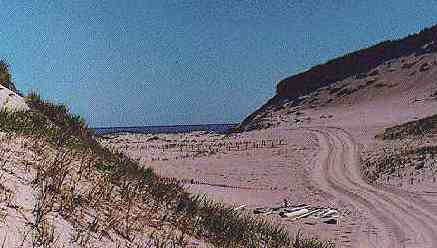 A "blowout" in
the dunes just behind the main WX station
A "blowout" in
the dunes just behind the main WX station
On the afternoon of June 24th, Ken and Wayne arrived and we began installing all of the HF beams and verticals for the lower bands. I then took a bit of a back seat on the HF operating and monitored more closely, and also did quite a bit of liaison between the two HF stations, advising them of possible openings on 10m/12m etc.
Thanks to all who spotted us on packet. It helped many work us when we QSYed to a supposed "dead" band. I wish more people would get on 10m/12m in the summer. I can't even count the times we CQed on 6 / 10/ 12m when beacons etc. were heard but no one on! Believe me, we kept a vigil, and many guys worked us on almost all bands 160-2m.
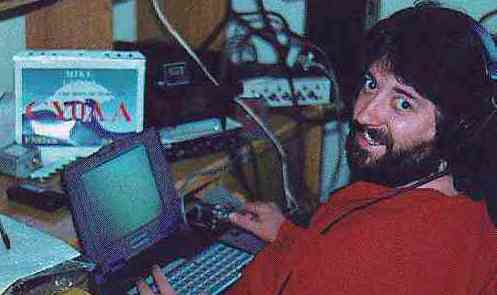 The man himself!
The man himself!
I was real hopeful many times for Europe every time I heard the video and when, one day I finally worked EH1YV I thought "THIS IS IT, GET READY!", my heart rate near doubled with anticipation but it was not to be. He is incidentally the first European EVER to have worked Sable on the six metre band.
EH8BPX was the first African, worked off the back of the beam one morning while working 40wpm+ MS into W2 land. He called in on SSB and I thought, "who is this?" I switched quickly over the SSB (which I often did, depending on propagation and stations calling me cross-mode) and got him.
On July 1st GJ4ICD came crashing through on CW. I worked him instantly but thought for sure it must be a slim; I had about given up all hope of working another European, and thought maybe some NA op was playing a cruel joke on me.
A few minutes later when I heard Geoff's voice I was some happy (you can't imagine!). I was a bit surprised that it really was GJ4ICD, as 48.250 video was about one notch above ESP and we had an small opening to USA off the back of the beam. Again my hopes soared and dreams of big EU> CYØ pileups were conjured up in my mind. Unfortunately only a handful of Europeans made it into the log.
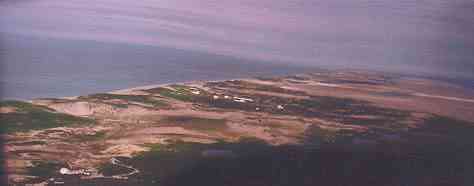 Another view of Sable
Another view of Sable
We were due to ship most of our gear on July 1st/2nd, but because of Sables' infamous fog, wind and rain we were delayed until the 6th before we were actually able to depart. At $370 per day + expenses, we were very happy to see the Brittain Norman islander touch down on the slightly soggy sand of the South Beach that afternoon.
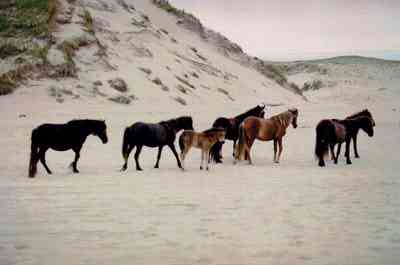 Some of the
Sable Ponies
Some of the
Sable Ponies
Although we never reached our goal of working scores of Europeans on six metres, plus many West Coast USA, I do feel that a good effort was made and that our operation was a success. Almost 1000 Japanese alone made it into the 20m log. There are around 600 QSOs in the 160m log and a whopping 926 into the six metre despite hardly any E-skip on that band. We were able to make a few "firsts" on Six and even on two metre EME. We were even a couple of guys' #100 on Six.
All in all 15,921 QSOs were made on 2m-160m CW, SSB, RTTY (satellite attempted but no QSOs). We understand that, due in part to the success of CYØAA, the weather station may be more willing to host other ham expeditions to Sable in the future, providing you meet all the requirements. It is possible that, due to government cutbacks, the Sable Island Station will be closing early in 1997. This would be a shame. The pristine landscape, 350+ wild ponies, and up to 80,000 seals would certainly be placed in jeopardy. Hopefully the rolling sandunes, soft flowing marram grass, and wide flat beaches of Sable will be protected for a long time to come. This is the hope of many that work and visit Sable, its landscape is like no other on Earth.
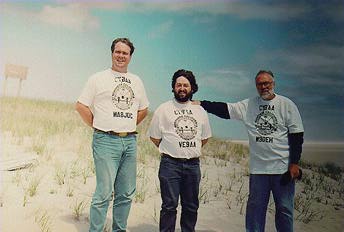 The Main CY0AA Operators
The Main CY0AA Operators
Hopefully now, after the CYØAA operation, Sable is knocked down a peg or two on the six metre needs ladder, at least in the Eastern half of the USA. NO west coast QSOs were made, and only a small handful of Caribbean, African, and European contacts were completed.
Our best guess is that this operation cost about $14,000 CDN, with much of the equipment/antennas and some of the money being donated by such groups as Oklahoma Comm Center, Icom USA, Cushcraft antennas, Heil, ICE, NCDXF, UKSMG, EUDXF, SMIRK, WJ2O QSLs, JPS , OZDX, and the many who sent sizeable private donations - W3IWU, GØJHC, WA8MSF, G3WOS, DL7AV, GJ4ICD, W5OZI, G3HBR to mention just a few.
Many thanks to ALL those that made this a success. Without your help, it would not have been a possibility. I am keen to return to Sable, or any other DX hotspot to put out six metres or 160m to many of the deserving. Hopefully we'll see better high band propagation next time.
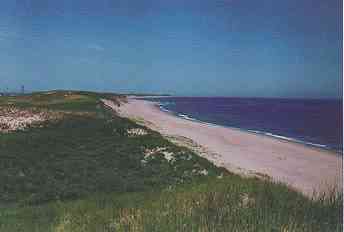 A Further view of Sable Island
A Further view of Sable Island
The following DX and European stations were worked from CY0:
First European QSO - EH1YV
First Africa - EH8BPX and later CT3FT
Europe (no order) - EH7KW, G4BWP, GW4LXO, ON4ANT, G4IGO, G3WOS, ON4GG, F5JKK, and GJ4ICD
North America - V47KV, KP4EIT, CO2PL, and C6ANY
"We understand that due in part to the success of CY0AA that the WX station may be
more amenable to host other HAM expeditions from Sable in the future, providing you still
meet all the requirements".
VHF QSLs go to VE9AA: Michael E. Smith 271 Smith Rd.(Geary) Waterville, Sunbury Co. NB Canada E2V 3V6 (new address). HF QSLs go to WD8SDL.